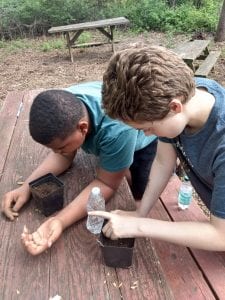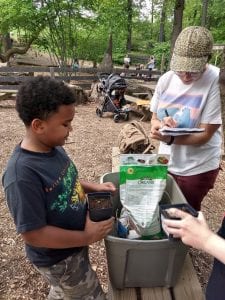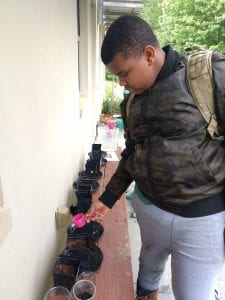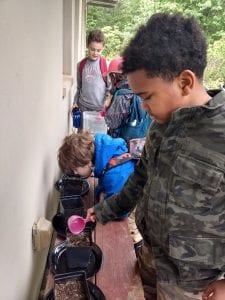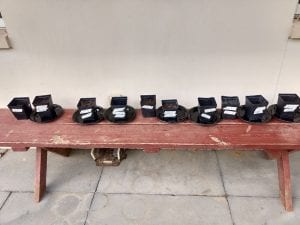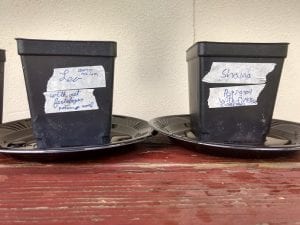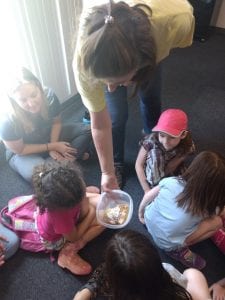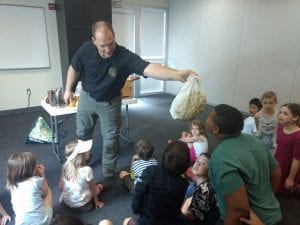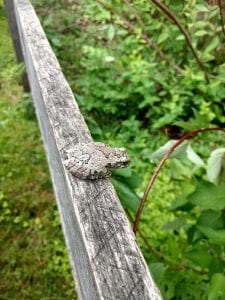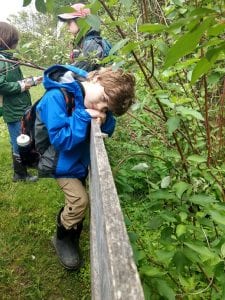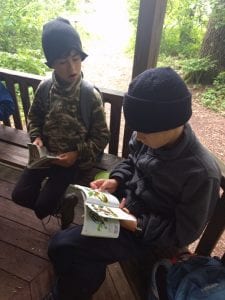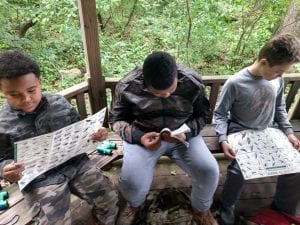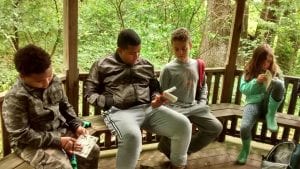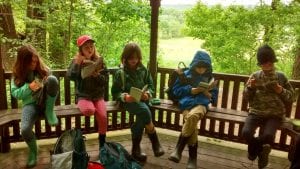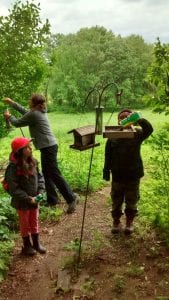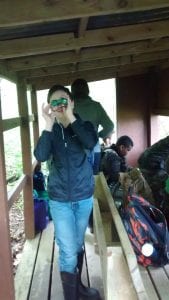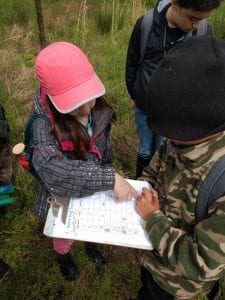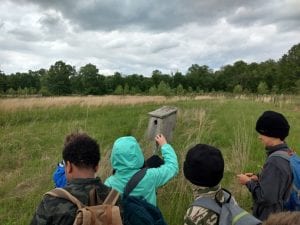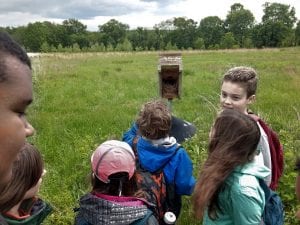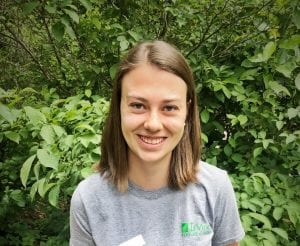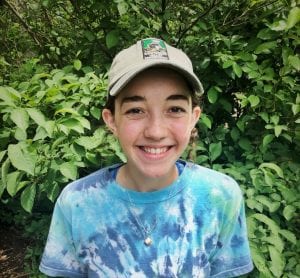Week 10: 5/7/19
Today we started a new experiment with plants and nitrogen. A few weeks ago during our citizen science project where we examined the health of a pond at Irvine, we learned about Nitrates and how they affect water quality. Nitrogen naturally occurs in our environment, existing in the air we breathe, soil and water. Humans have put a lot of extra nitrogen in our environment, mostly through fertilizer. So we decided to test this with our own seedlings.
In pairs we decided on whether we wanted to plant with potting soil or Irvine soil and then one of the pairs chose whether they were going to use fertilizer or no fertilizer. We labeled all the plants with the soil type, whether it had fertilizer and what was planted. We planted nasturtiums, peppers and watermelon. During our last three classes we will be monitoring our seeds and seeing which ones are growing first, the fastest and measuring them. Our plants will receive the same amount of water and light. The goal of our experiment is to see if nitrogen is affecting the growth of any of the plants.
Next we introduced our new land artist. Please scroll down to see his artwork. We also introduced our next citizen science project which we are going to work on next week. This project will include recording bird sightings and what is in various nest boxes around Irvine’s meadows. Stay tuned for our results!
The rest of class we were treated to a special guest, Mrs. Avril’s husband who is also a beekeeper. We enjoyed a fun and very informative talk about bees. Here are some of the cool facts we learned and remembered. Also, check out the links below to learn more about bees, how they help people and why they’re critical to the survival of our ecosystems.
Cool bee facts:
The queen be is chosen by the colony and is fed something called “royal jelly” that makes the queen larger than the other bees
A homeless group of bees is called a swarm. They are harmless and are looking for a new home as they protect their queen in the swarm
Almost all bees are female, only a few males (drones) live in a hive.
It takes almost 1,000,000 flowers to make 1 lb of honey
Bees make wax and use it to create their hive. Each chamber in the hive are a mathematically perfect hexagon
Bees make their honey thick by stirring it with their proboscis (tongue) and fanning it with their wings to evaporate water down to a certain percent
Bee bread is made out of honey and pollen and is fed to young bees
Pollen baskets are hooks on the back of bees legs that the bees roll pollen with so they can transport it back to the hive
Beekeepers use color coded dots on the queen bee to tell what year she was born in
Bees do not cross pollinate plants
Almond trees rely exclusively on bees to be pollinated to produce almonds, so much so that bees are shipped to California to help pollinate them
Get the buzzzz on bees:
Why do we need to help bees?
How can you help bees:
https://thehoneybeeconservancy.org/how-to-save-the-bees/
Week 11: 5/14/2019
Today was all about birds! We got to work on our citizen science project that we introduced last week along with our nature artist Jayson Fann, more on him next week. Our day learning about birds began in the best way possible. We heard a Carolina Wren singing only feet from us. Soon he popped out of the bushes and we were able to get a good visual. Being able to visually link a bird to the song that you hear is the best way to learn that bird’s song. Learning bird song takes a lot of practice, especially since birds have numerous songs and calls per species and those songs and calls can even vary by region! A great source for learning more about birds is this website:
https://www.allaboutbirds.org/
Check out the Grey Tree Frog we found on the fence below. That camouflage is amazing!
After an amazing bird encounter and checking that species off our bird list, we hiked down the Vista Loop Trail towards the gazebo. Before we got to the gazebo we saw our next bird on our list. It was spotted by one of the kids with their binoculars. We crept closer and saw that is was a robin sized bird on the trail with a brown back and a white chest with spots. I quickly identified it as a Wood Thrush. After everyone got a chance to see the bird in person we opened our field guides in the gazebo and searched for Wood Thrush. We reviewed, as a group, where the bird lived, what it ate and other information you can find in a bird field guide. The best field guide to use for birds is “The Sibley Field Guide to Birds of Eastern North America” by David Allen Sibley.
While we were in the gazebo we identified another new bird, the Downy Woodpecker, that we saw on a nearby tree. After reading more about these new birds, including the nests they build, we hiked down to the wildlife blind. Here we saw a Brown-headed Cowbird. We talked about how these birds lay their eggs in other bird’s nests and since they are larger than their nest companions they usually win the competition and the bird mom takes care of them (even though its not her baby). Also at the feeder we spotted a red-winged blackbird.
We headed into the meadow and started our bird box survey. All around Irvine’s meadows are bird boxes that were put up in order to encourage a variety of nesting bird species. The boxes generally have Tree Swallows in them but occasionally we will find Eastern Bluebirds and Carolina Wrens. We talked about bird box ettiquette and how to properly check a bird box. First we knock on the box gently to let any adult birds know we are there and give them a chance to fly out, next we wait for an adult to help us open the door of the bird box, very slowly. We look inside and quickly count the number of eggs in the nest and identify the species if we can (color and markings on the eggs). We also take note of the materials the nest is made of. We record the bird box number on our sheet and the nest information. This information is used by people who monitor these boxes to tract what species are nesting in the boxes, how many eggs they lay, when the eggs hatch and when the young fledge and so on.
As we hiked throughout the Pollinator Meadow we continued to check our bird boxes and record what we found inside the boxes, whether the box was empty, had an empty nest, had eggs or even hatchlings. One of our boxes had Tree Swallow hatchlings, which was a very exciting find! We also talked about how our bird boxes at Irvine should be placed in pairs because of the territorial nature of Tree Swallows. If you place two boxes close together the Tree Swallows will choose one box and then discourage other Tree Swallows from nesting in the adjacent box, which then allows other species to move in, like the desired Eastern Bluebird. In the meadow we also found a very cool pickerel frog!!
At the end of class we hiked up the road and found our bird box with the baby blue birds. We saw mom blue bird on the fence waiting outside the box. We quickly checked inside and found 5 newly hatched baby bluebirds! We took down our information, closed the box and walked away, allowing mom to fly in and feed her babies. What a great way to end our day that was all about birds!
Overall we found 15 bird species for our Bird-A-Thon list! Check out our results below and our notes for the bird box survey.

